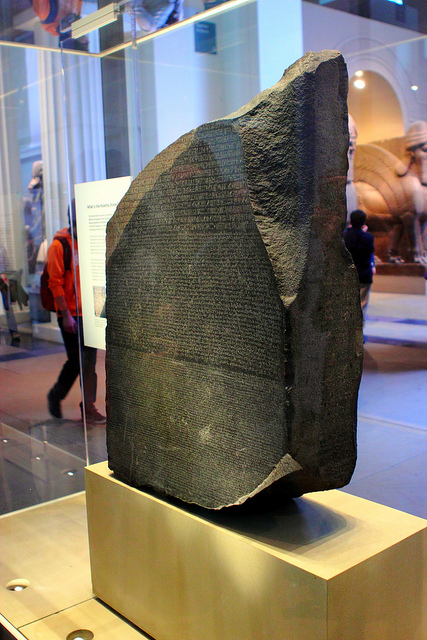The Rosetta Stone حجر رشيد Posted by Fisal on Jul 20, 2011 in Arabic Language, Culture, Vocabulary
The Rosetta Stone is an ancient Egyptian basalt stele inscribed with a decree فرمان issued in Memphis منف , Egypt in 196 BC on behalf of King Ptolemy V بطليموس الخامس . The decree appears in three scripts: the upper text is ancient Egyptian Hieroglyphs اللغة الهيروغليفية . The middle portion is Demotic اللغة الديموطيقية and the lower is ancient Greek اللغة اليونانية . The stone provided the key to the modern understanding of the ancient Egyptian Hieroglyphs because it presents the same text in all three scripts.
It is thought that the stone was originally displayed within a temple and then moved during the medieval period and finally used as a building material in the construction of Fort Julien (Kaupay Fortress قلعة قايتباي in Arabic) near the town of Rashid رشيد (Rosetta) in the Nile Delta. It was rediscovered there in July, 1799 by a soldier of the French Expedition الحملة الفرنسية toEgypt. As the first bilingual text recovered in modern times, the Rosetta Stone aroused widespread interest with its potential to decipher the ancient Egyptian language that was dead at that time. Lithographic copies and plaster casts began circulating amongst European museums and scholars.
The British troops defeated the French in Egyptin 1801 during the Napoleonic Wars حروب نابليون and the original stone came into British possession after the capitulation استسلام of Alexandria. Transported to London, the stone has been on public display at the British Museum المتحف البريطاني since 1802. It is the most-visited object in theBritishMuseum. Since 2003, there have been unsuccessful demands for the stone’s return toEgypt.
Study of the decree الفرمان was already under way as the first full translation ترجمة of the Greek text appeared in 1803. However, it was 20 years before the decipherment of the Egyptian text was announced by Jean-Francois Champollion جان فرانسوا شامبليون inParis in 1822. Still, it took longer before scholars were able to read other ancient Egyptian inscriptions and literature confidently. Major advances were: recognition that the stone offered three versions of the same text (1799); that the demotic text used phonetic characters to spell foreign names (1802); that the hieroglyphic text did so as well and had pervasive similarities to the demotic (Thomas Young, 1814); and that in addition to being used for foreign names, phonetic characters were also used to spell native Egyptian words (Champollion, 1822-1824).
Two other fragmentary copies of the same decree were discovered later, and several similar Egyptian bilingual or trilingual inscriptions are now known, including two slightly earlier Ptolemaic decrees (the Decree of Canopus in 238 BC, and the Memphis decree of Ptolemy IV, ca. 218 BC). The Rosetta Stone is therefore no longer unique, but it was very important in reading the ancient Egyptian Hieroglyphic Language.
* Adapted and translated from wikipedia
*********
Check us back soon
Peace سلام /Salam/

Build vocabulary, practice pronunciation, and more with Transparent Language Online. Available anytime, anywhere, on any device.
About the Author: Fisal
Well, I was born near the city of Rasheed or Rosetta, Egypt. Yes, the city where the Rosetta Stone was discovered. It is a small city on the north of Egypt where the Nile meets the Mediterranean. I am a Teacher of EFL.





Comments:
Juan:
It is a pity that this important and historical discovery is not exposed where it belongs: Egypt.
All civilized nations have strict laws to protect their own patrimony, however, they do not apply their own laws when it is against their interest.
Juan
Fisal:
@Juan Agreed, Juan. Self-interest is the key ..!!
Gola Womens Pewter Mint Ala932 Verde Active Wear Trainers:
Interestingly reviewing this article plenty will like this since it’s true and its good seeing an author thats telling things on this for all to see to read.